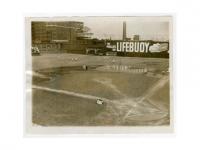Once surrounded by North Broad Street, West Huntingdon Street, North 15th Street and West Lehigh Avenue, the stadium that became known as the Baker Bowl was the first home of the Philadelphia Phillies. It opened in 1887 and was called by several different names, including "The Cigar Box," the Philadelphia Base Ball Grounds, and National League Park. It was during the tenure of William F. Baker as Phillies owner (1913-1930) that its current moniker stuck.
The first park built on the site suffered a fire several years after its construction. The second park, completed in 1895, was constructed of steel and brick and hailed as one of baseball's most modern parks. The Baker Bowl endured a second tragedy in 1905 when a portion of its bleachers collapsed during a game.
Regardless of what the Baker Bowl went through, it was the home of the Philadelphia Phillies for over fifty seasons. The park saw the first World Series game attended by a sitting U. S. president, with Woodrow Wilson and the First Lady as spectators during the second game between the Phillies and the Boston Red Sox. The Baker Bowl was also the host of several Negro League games, and during the 1930s it hosted the Philadelphia Eagles football club.
It was also during the 1930s that the Baker Bowl began showing its age. By the end of the decade the park’s deterioration forced the Phillies to move. They began playing at Shibe Park in 1938, home to the city's American League team, the Athletics. Rather than immediately demolishing the Baker Bowl, it was converted to host other events, such as racing. The park was finally torn down in 1950.
More views of the Baker Bowl from the 1920s to 1940s are in HSP's Philadelphia Record photograph morgue (#V07). This same collection contains many photographs of the city's baseball activities and venues during the early 20th century. Publications on the history of baseball, both locally and nationally, are also available in our library.
Image: Baker Lake [Baker Bowl] right after the storm, photograph (1938)

